Author: Matt Del Fiacco
As any all grain brewer is well aware, sweet wort is created during the mash in what is termed the saccharification rest. When crushed malted grain is steeped with water at temperatures ranging between about 131°F/55°C and 165°F/74°C, diastatic enzymes are activated that convert the dry starch into a fermentable liquid consisting largely of maltose and some unfermentable dextrines.
Modification is a term used to describe the how much of the endosperm in grain has been broken down during the malting process– the higher the modification, the less work the enzymes activated during the mash have to do. Given the higher modification of modern malts, single infusion mashing has become incredibly common among brewers, not only because of its simplicity, but because it works. But this hasn’t always been the case.
In the early days of brewing, malts weren’t as well modified as they are today, which meant that even a long rest at saccharification temperatures wasn’t enough to break down certain proteins, which had detrimental effects on head retention, body, and appearance. Moreover, the use of non-malted grains contributed to the problem. To combat this, brewers relied on techniques that involved holding the mash at temperatures known to activate other enzymes. One such example is the protein rest, which occurs when the mash is held between 113°F/45° and 131°F/55°C for 15 to 30 minutes. During this rest, proteolytic enzyme is activated and begins to break down larger protein molecules into smaller amino acid chains, making the starch more accessible to the diastatic enzymes activated during the saccharification rest.
Despite the availability of highly modified malt and claims protein rests can actually hinder body and head retention, some brewers continue to rely on this traditional method under the belief it contributes something positive to their beer. As someone who frequently uses adjuncts in my brewing and has employed the many protein rests without issue, I decided to test it out for myself!
| PURPOSE |
To evaluate the differences between a beer made using a protein rest and one made using a single infusion mash, the grist of which was comprised entirely of well modified malted grains.
| METHODS |
I went with a very simple American Wheat Ale for this xBmt.
Protein Spirit
Recipe Details
| Batch Size | Boil Time | IBU | SRM | Est. OG | Est. FG | ABV |
|---|---|---|---|---|---|---|
| 5 gal | 60 min | 19.6 IBUs | 4.3 SRM | 1.053 | 1.014 | 5.1 % |
| Actuals | 1.053 | 1.007 | 6.1 % | |||
Fermentables
| Name | Amount | % |
|---|---|---|
| Wheat Malt, Red (Rahr) | 5 lbs | 55.17 |
| Pale Malt, 2-Row (Rahr) | 3.625 lbs | 40 |
| Vienna Malt (Weyermann) | 7 oz | 4.83 |
Hops
| Name | Amount | Time | Use | Form | Alpha % |
|---|---|---|---|---|---|
| Cascade | 15 g | 60 min | First Wort | Pellet | 6.5 |
| Cascade | 28 g | 5 min | Boil | Pellet | 6.5 |
Yeast
| Name | Lab | Attenuation | Temperature |
|---|---|---|---|
| American Wheat Ale (1010) | Wyeast Labs | 76% | 58°F - 74°F |
Notes
| Water Profile: Ca 68 | Mg 0 | Na 10 | SO4 70 | Cl 65 |
Download
| Download this recipe's BeerXML file |
I started my brew day by collecting RO water, adjusting it to my desired profile, then kicking on the electric controllers to heat it up.
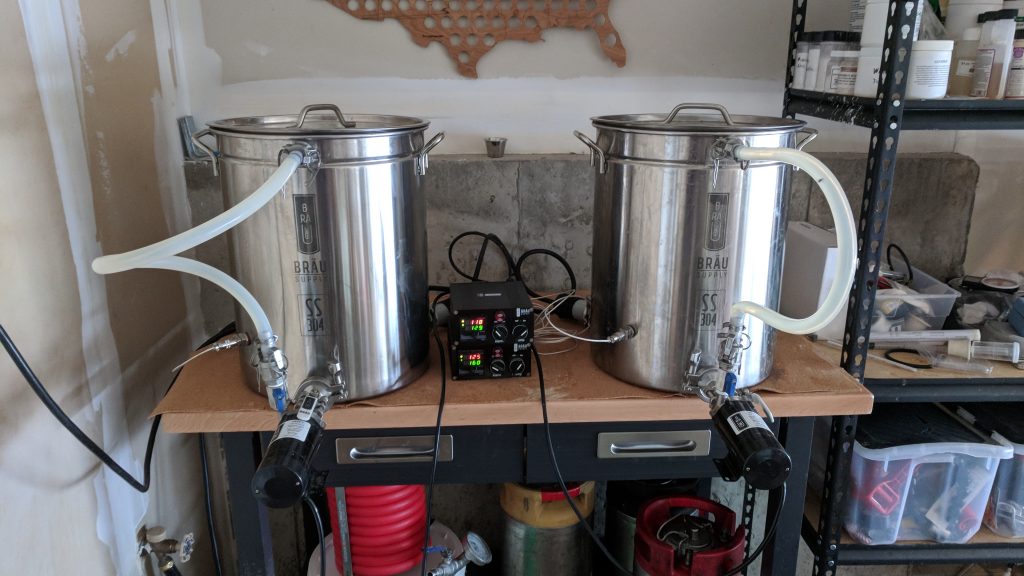
While waiting, I weighed out the kettle hop additions.
As strike temperature neared, I weighed out and milled 2 identical sets of grain.
The protein rest batch was ready first, so I added the grains and stirred before checking to ensure it was at my target temperature of 126°F/52°C. After a 25 minute rest, I raised the temperature to 155°F/68°C for saccharification rest, which took about 10 minutes, then let it rest for another 25 minutes for a total of 60 minutes.
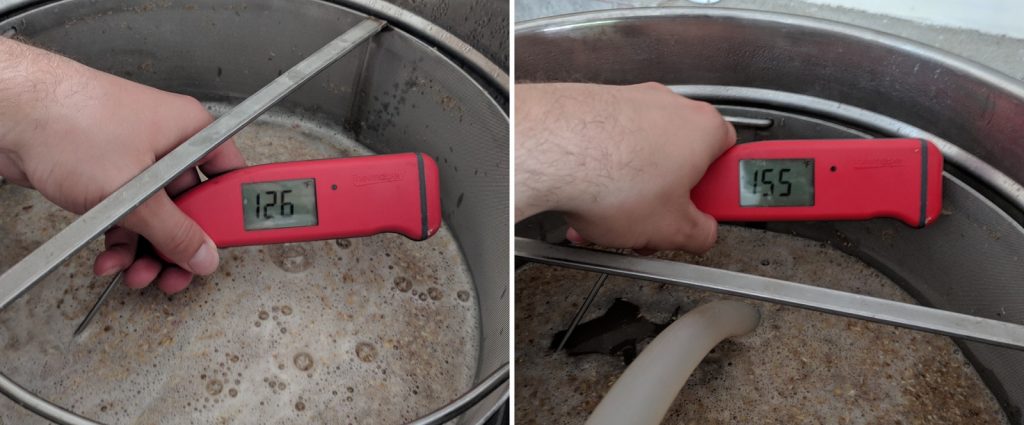
The single infusion batch sat at the same saccharification temperature for 60 minutes.
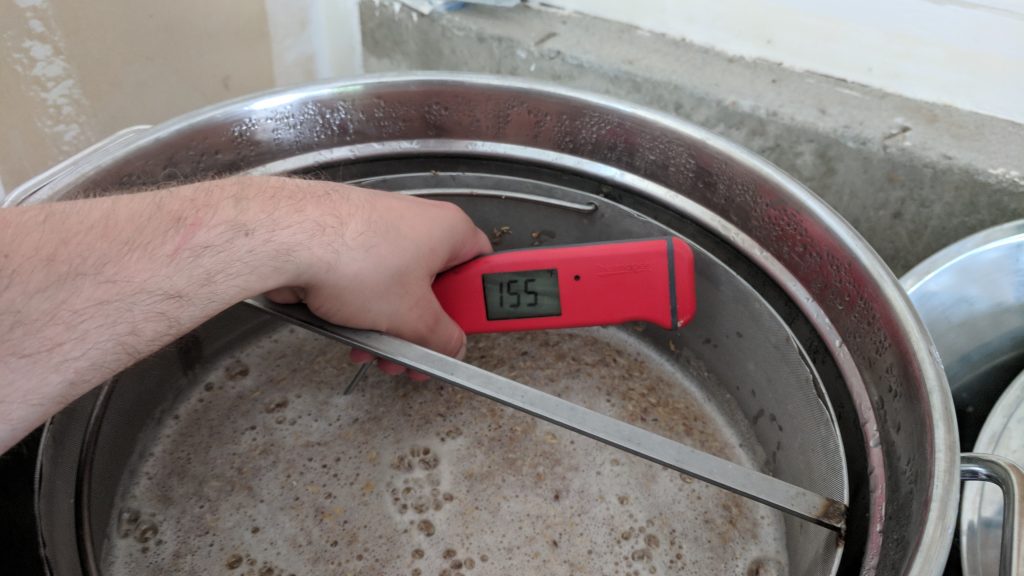
When the mashes were completed, I removed the grains and boiled each for 60 minutes, added hops per the recipe. At the end of each boil, the worts were quickly chilled with my counterflow chiller and ran directly into identical fermentors.
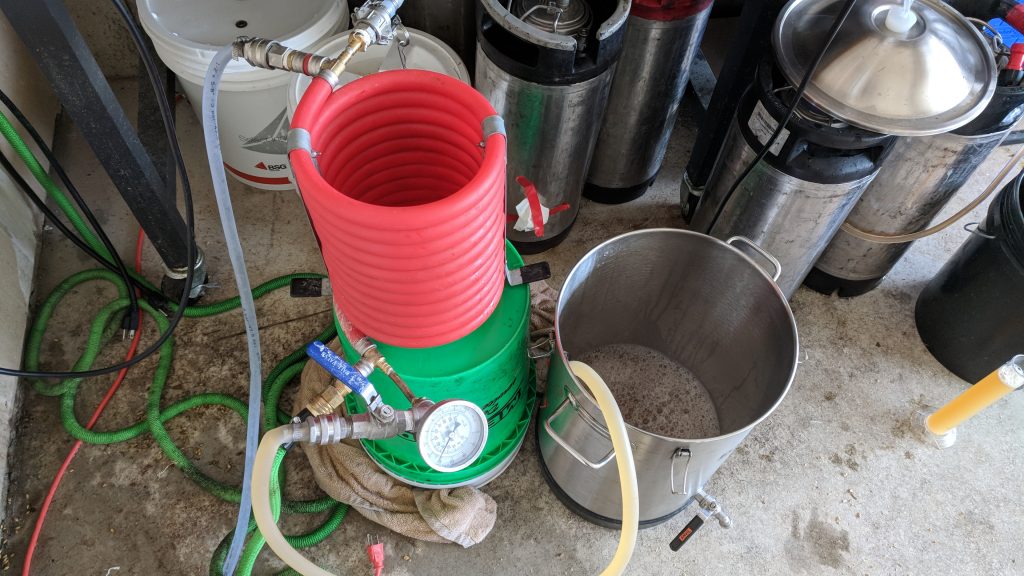
Hydrometer measurements showed the protein rest batch had a slightly higher OG than the single infusion batch.
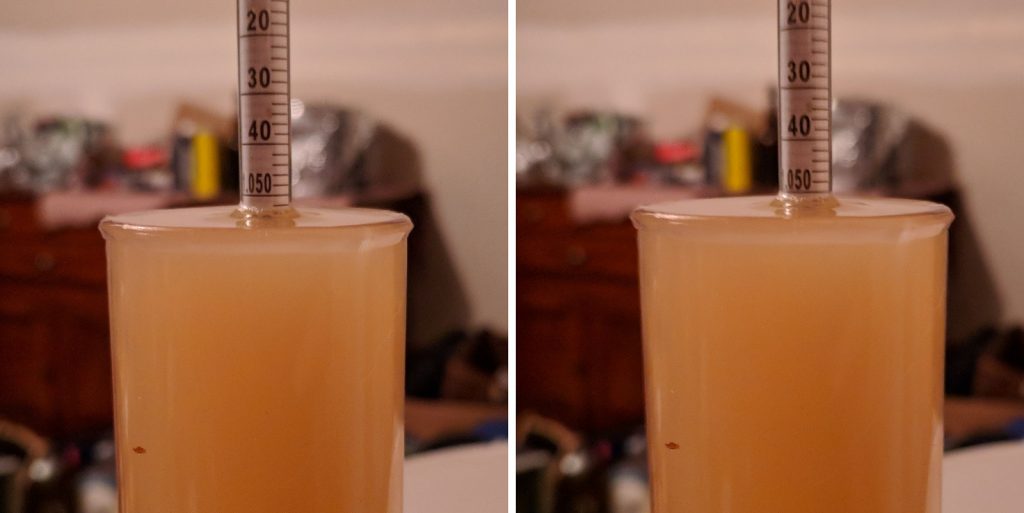
The worts were allowed to chill to my intended fermentation temperature of 64°F/18°C before I returned to pitch equal amounts of yeast starter into each. I observed fermentation activity from both beers within several hours and left them alone for 12 days before confirming FG had been reached.
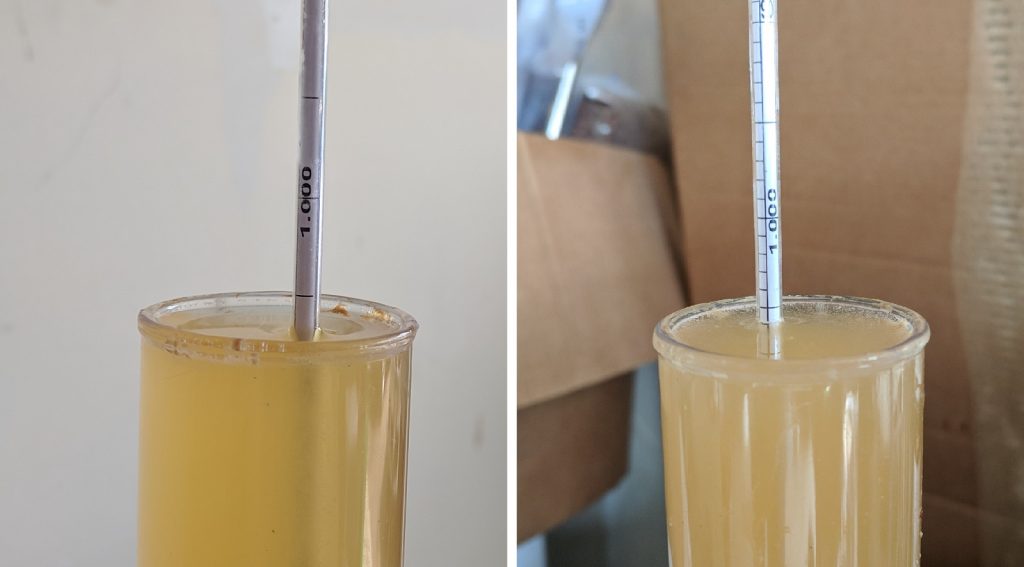
The beers were then transferred to serving kegs.
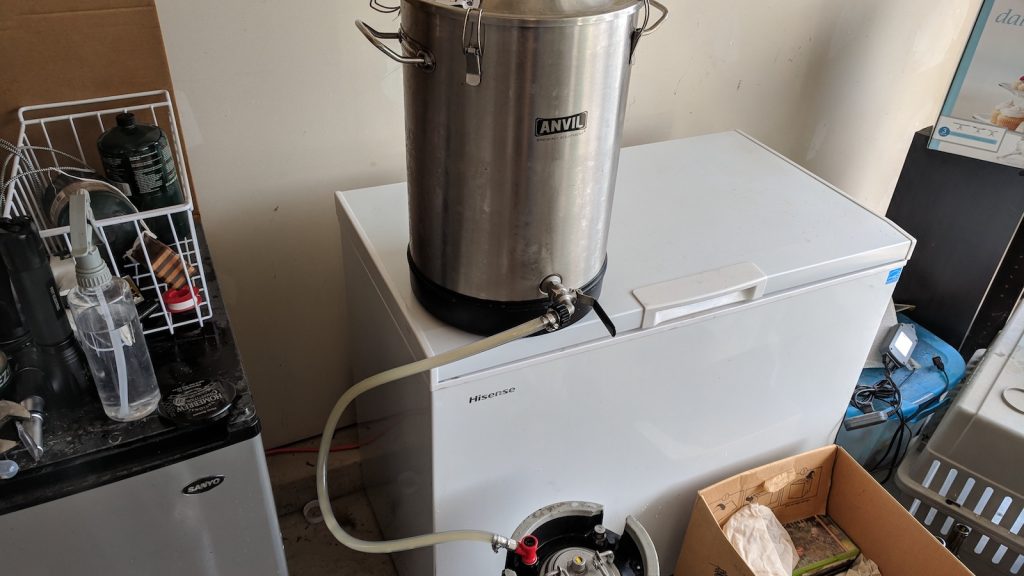
The filled kegs were placed in my cool kegerator and burst carbonated before I reduced the pressure. After a few days of cold conditioning, they were ready to serve to participants!
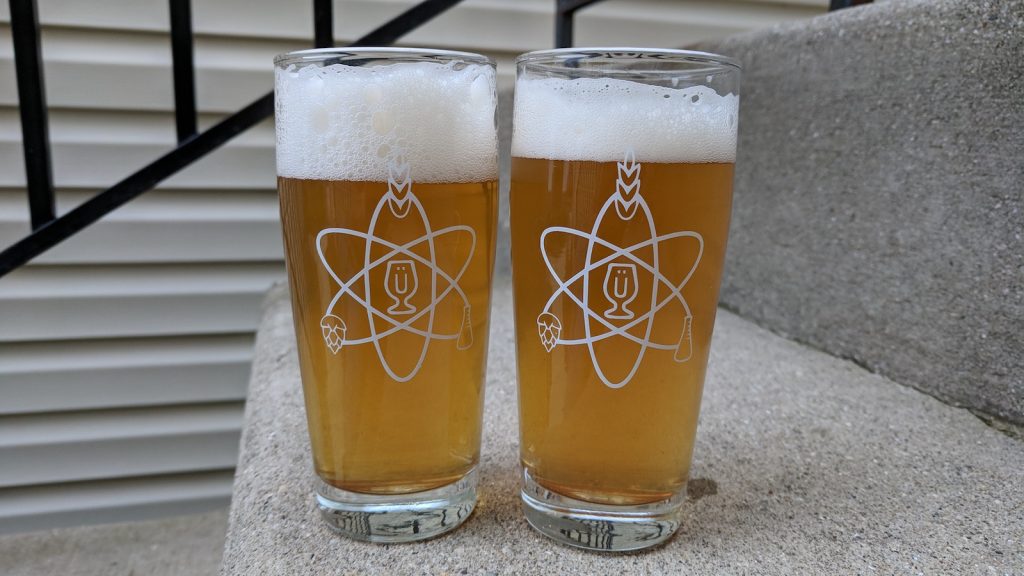
| RESULTS |
A total of 22 people of varying levels of experience participated in this xBmt at the CHAOS Brew Club 2018 Summer BrewBQ. Major cheers to the organizers for allowing me to collect data during this incredible event!
Each participant was served 1 sample of the protein rest beer and 2 samples of the single infusion mash beer in different colored opaque cups then asked to identify the unique sample. At this sample size, 12 tasters (p<0.05) would have had to identify the unique sample in order to reach statistical significance, though only 7 (p=0.64) made the accurate selection, indicating participants in this xBmt were unable to reliably distinguish an American Wheat Ale brewed with a protein rest from one brewed using a single infusion mash.
My Impressions: I attempted 4 semi-blind triangle tests with these beers and selected the unique sample only twice, both times were guesses. To my palate, the protein rest had no impact at all on the body of the beer, I perceived the same mouthfeel in both. The beers had a really pleasant raw dough character in the flavor and the hop character was virtually absent. It wasn’t bad, though not my best work, in future iterations I may tone down the bittering bit.
| DISCUSSION |
Many publicly available recipes, some of which come from respected brewing authorities, list a protein rest as a step in the brewing process. It’s possible this is for historical purposes, cases where a protein rest would have been used in the earlier days of the style, or it could be because the beer is made with a large portion of unmalted adjuncts. While such a rest may very well serve a purpose in certain situations, some contend it can lead to poor head retention and negatively impact the body of the beer when used with grists consisting of all modified malts. It’s for this reason I brewed a beer using all well modified grains for this xBmt, and the fact tasters could not reliably tell them apart suggests the protein rest did not have a noticeably strong impact on flavor, aroma, or mouthfeel.
But what about foam? I poured equal sized samples of each beer and let them sit out for 3 minutes to observe any differences in head formation and retention.
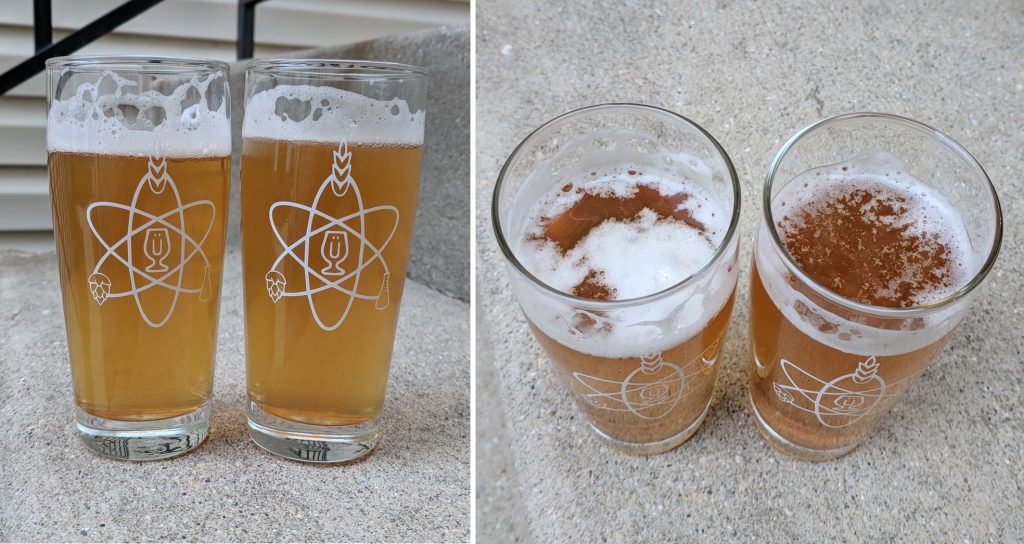
To my eyes, the head on the beers looked more similar than different, though the protein rest version did retain a larger foam raft, which counters the claim that performing a protein rest when the grist consists of highly modified malts leads to poorer foam quality. Furthermore, I noticed no differences in clarity between the beers. While I don’t see myself using a protein rest in future batches, these results have left me feeling pretty confident that doing so even when it isn’t necessary likely won’t be detrimental.
If you have any thoughts about this xBmt, please do not hesitate to share in the comments section below!
Support Brülosophy In Style!
All designs are available in various colors and sizes on Amazon!
Follow Brülosophy on:
FACEBOOK | TWITTER | INSTAGRAM
If you enjoy this stuff and feel compelled to support Brulosophy.com, please check out the Support page for details on how you can very easily do so. Thanks!

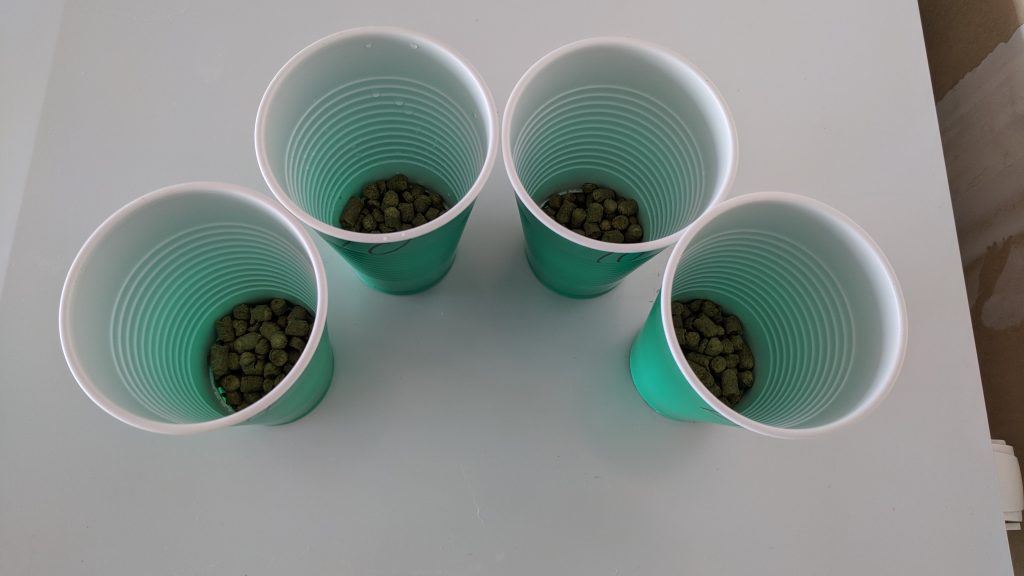
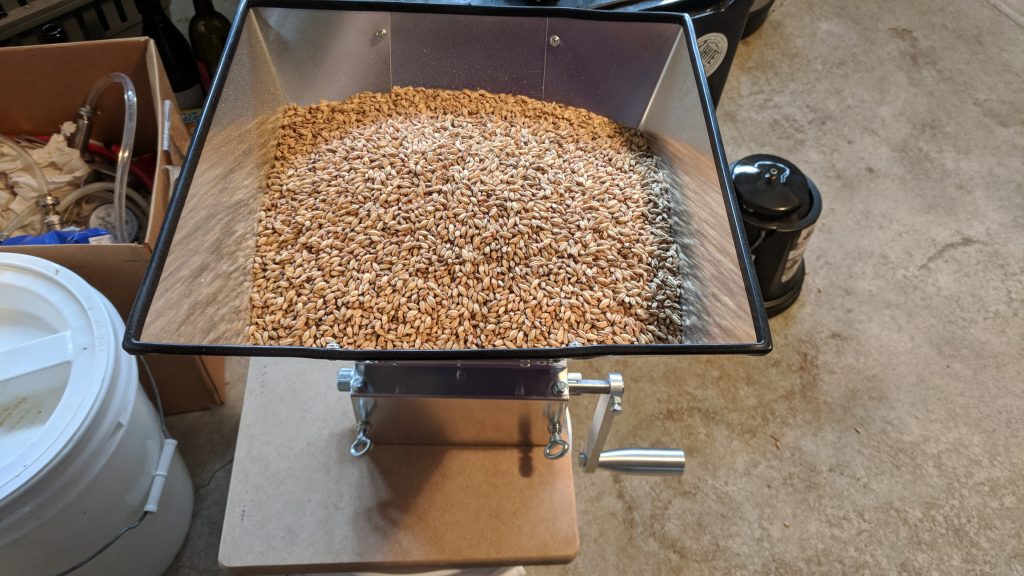











15 thoughts on “exBEERiment | The Mash: Protein Rest vs. Single Infusion In An American Wheat Beer”
This is good info, though of course I wonder if the results may be different with a different grain bill. While I did a few protein rests early on after switching to all-grain brewing, I’ve been using single infusion almost exclusively since then (aside from a few messy experiments with decoction mashing). It’s worked fine for me, and these results seem to confirm that (at least for a simple grist of well modified malts) the protein rest can probably be skipped without dire consequences.
I’m certainly open to different results with a different grain bill! After this xbmt, I’d like to replicate it with a large portion of un(der) modified grains.
For what it’s worth, I’d love to see a repeat with a beer that used Weyermann’s Floor Malted Bohemian Pilsner. It’s a moderately modified malt.
In my own experience, it has not been possible to get a fully bright beer using that malt without a protein rest. Even a month’s lagering wouldn’t totally clarify a helles I made with it and a single infusion.
Many years ago I beat chill haze with protein rests. In any beer with crystal malt, I’d have haze. Adding a ten minute protein rest, followed by direct heat to raise the mash to sachrification temperature got rid of it.
I’d love to try this one again with un(der) modified grains! I definitely didn’t notice a clarity difference in these beers, which was surprising. But I do think the mash is dependent on the grain, so doing this again in different contexts is on my list of things to work with.
What about something with a lot of wheat? Specifically- a German weissbier? something with a 50-50 or 60-40 wheat/barley ratio?
When I was over in Germany, the brewers I talked to all seemed to stress that the rest is important. Whether there was some legitimate technical reason for this… or if it was just a matter of sticking with tradition (which is a VERY German thing to do- especially with beer), I could never get a straight answer out of them.
Czech Beer Research Institute published article about differences among infusion, single, double and triple decoction methods using moderately modified malt in 2005. Available here: https://www.kvasnyprumysl.cz/pdfs/kpr/2005/05/01.pdf in Czech and English also. There is not as much information about protein rest but it may be helpful for you anyway.
Is a “foam raft” considered a flaw?
Not necessarily in my experience, but it depends on the beer style.
I’ve recently been using Ireks Pilsner malt in many of my beers. I’ve done one lager with a 15 minute protein rest and the rest just a sacchrification rest. I have not noticed any head retention differences but definitely noticed a brilliant clarity difference in the pils with the protein rest. All the beers cleared with time but the pils was brilliant right away. I definitely agree this is most likely malt bill dependent as malters all have their various processes to create the same style of malts. Great xbrmt again!
At what temperature did you do the protein rest?
The foam comments are interesting. Rule of thumb for me: American Grains – Single infusion, European and 6-row with adjuncts – Hochkurz Double Decotion.
I concur with the clarity benefits, I have a small HERMS system, using a small stainless coil that can fit inside a kitchen kettle, so easy for me to just dough in at any old temp, then dial in some rests during the heating process.
So I usually run a Glucanase rest at 44c or 111F then Protein rest at around 55C or 131F.
I get a much much better flow through the grain bed with the Glucans being broken down in the first rest, my rice hulls are sittting there unused since I started doing this, even when using heaps of unmalted wheat, Rye etc, stuff with lots of protein and glucans,
What I get from the protein rest though I have found is no chill haze and bright beer, which for me, using No-Chill, has been more of an issue. So I said byby to chill haze since running these.
Not that it would be that interesting I expect, but if you ran this again and ‘No-Chilled’ one half and chilled the other, then served up cold and showed the visual comparison, all other things being equal, I’d say you would see a difference in clarity, possibly quite a large one.
Not sure how effective Gelatin is on chill haze, that would be another consideration however.
Thanks for this exbeeriment in any case, which has given me the confidence to run the protein rest at a slightly lower temp, as I was fearing the damage to head retention, so I was leaning toward the highest end of the protein rest range, which was resulting in quite a bit of Beta Amylase activity and beers with lower than predicted FG’s
I have to second the replies on protein rests reducing haze. I used to mash in a cooler and boil with propane and never had issues with haze. My beers would typically clear up nicely in a week or so with only gravity and refrigeration. I recently switched to a Grainfather (which I love and wished I had done years ago!) and started having issues with haze. Even gelatin didn’t quite clear it up although given enough time (typically a month or more) the beer would clear. I started doing a protein rest and my beer is brilliantly clear again! I’m not sure if it has to do with the “less vigorous” boil of the Grainfather or something else, but I’m now a protein rest guy. Even with the extra rest my brewday is still shorter and more relaxing than ever before. Did I mention I love my Grainfather?
This experiment would have had a lot more merit with a large proportion of unmalted grains.
It is my understanding that the primary purpose of a protein rest is to prevent the proteins from gumming up the mash and causing a stuck sparge. Your brewing method did not include sparging. Also, protein rests ensure that you will have consistency irrespective of the degree of modification of the wheat malt used.
In other words, there are cases in which a protein rest makes sense, and cases in which it doesn’t. Your brew appears to be one of the latter.